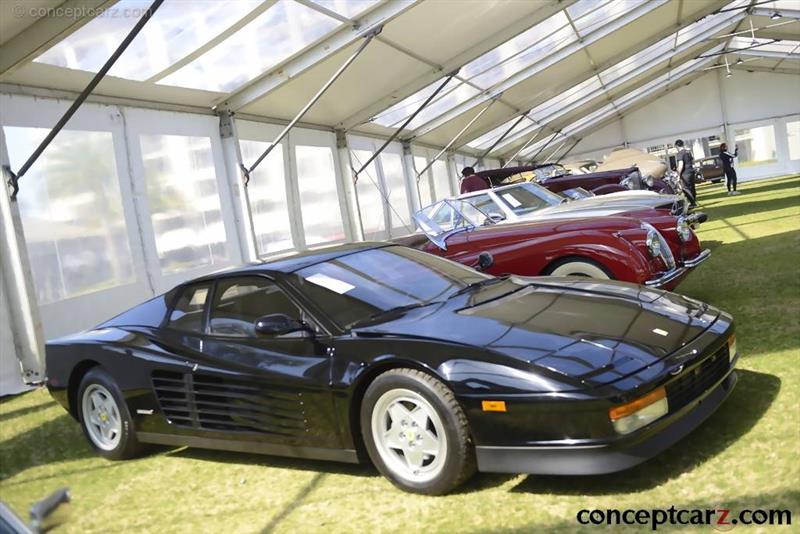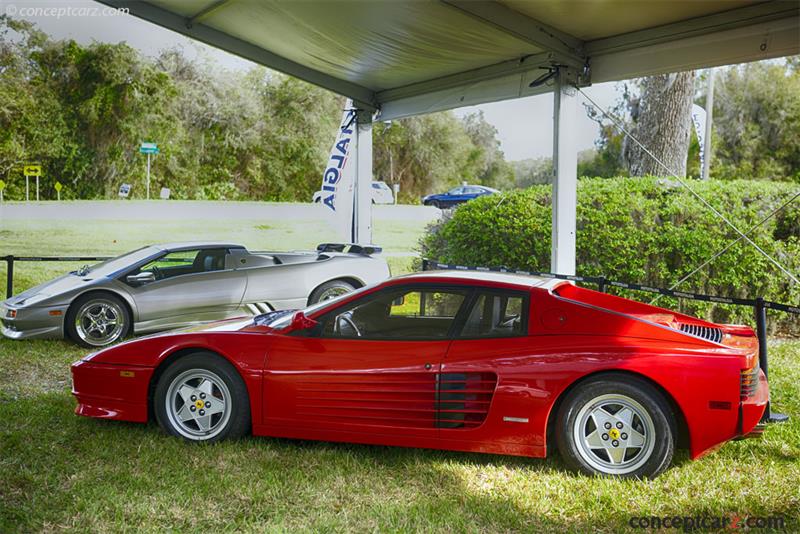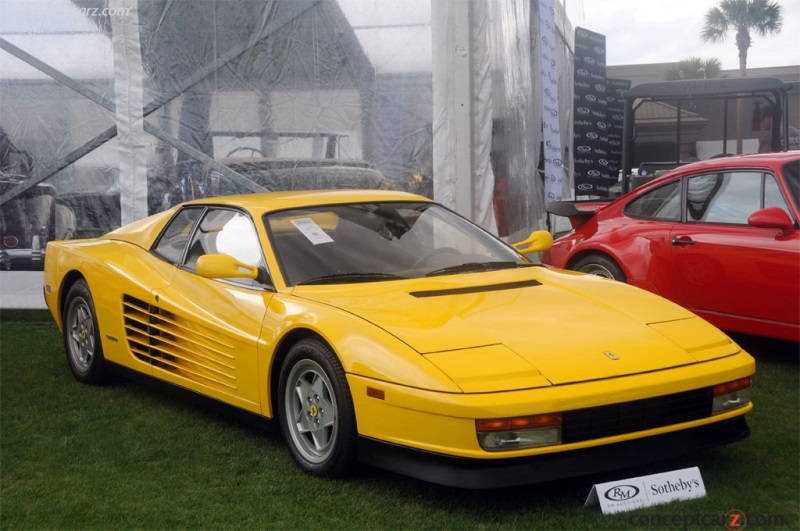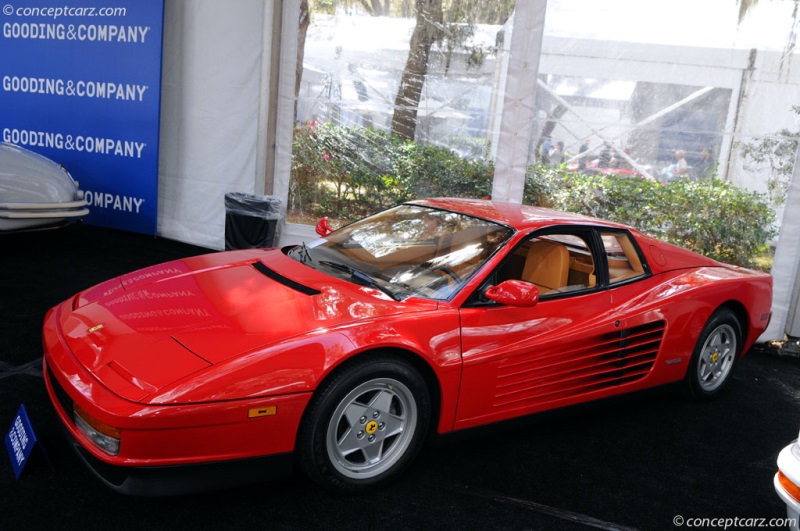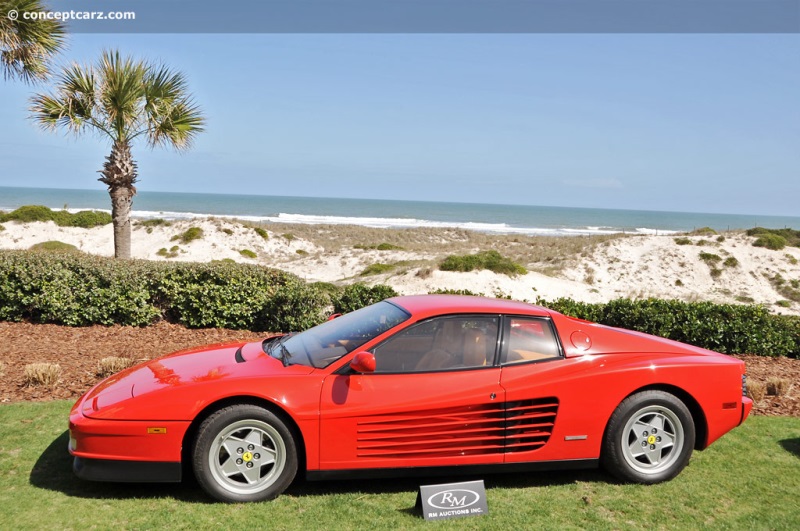The Ferrari Testarossa was unveiled in 1984 at the Lido on the Champs-Elysees on the eve of the 1984 Paris Salon de l'Auto signaling the end of production of the Boxer, the company's flagship 12-cylinder Ferrari model for the previous decade. The styling by Pininfarina paid homage to the legendary 1950s sports racer that originally bore the name, simply translating as 'Red Head,' referencing its rocker covers being painted red. The center of gravity was positioned in the middle car thanks to its mid-engine rear-wheel-drive configuration, with a weight distribution ratio of 60% rear and 40% front, thus achieving excellent cornering and road-holding ability. The Testarossa was larger than its Boxer predecessor, six inches wider, and approximately 2.5-inches longer, accommodating additional interior leg room. The visually stimulating and distinctive side vents allowed excellent engine ventilation, whilst contributing to the car's unique, crisp, square-cut styling.Mechanical Specification
The free-revving, naturally aspirated 4.9-liter (4943cc), flat, dry-sumped, longitudinally-mounted, 180-degree V12 engine provided 385 horsepower, a zero-to-sixty mph time of 5.2 seconds, and a top speed of 180 mph. The all-alloy unit had four valves per cylinder (48 valves in total) actuated by dual overhead camshafts (DOHC), a compression ratio of 9.20:1, and 361 ft-lbs (490 Nm) of torque at 4,500 RPM. The aluminum pistons moved in Nikasil cylinder liners and rotated a seven main bearing, hardened steel, billet-turned crankshaft via forged steel connecting rods. The combustion chambers were ellipso-hemispherical. Two Bosch KE Jetronic systems metered fuel flow, one for each bank of cylinders, and delivered to the injectors by two electric pumps. Twin coils provided spark through their own Weber-Marelli Microplex-controlled distributors. Tube steel manifolds, catalytic converters, and a tuned exhaust system managed the dispersal of the combusted mixture. A single water pump and twin side-mounted radiators kept the engine cool. The 'ROW' (Rest of the World) version produced 385 horsepower at 6,300 RPM while the U.S. version developed slightly less power, at 380 hp. The engine was paired with a five-speed manual transmission with a final drive ratio of 3.210:1. The ventilated disc brakes measured 12.17 inches (309 mm) at the front and 12.20 inches at the rear, and the hydraulically assisted four-piston calipers were controlled by separate circuits front and rear. The parking brake acted on small drums contained within the rear discs. The brakes resided behind magnesium single bolt 'knockoff' wheels with a 16.33 inch (415 mm) diameter wrapped with Michelin TRX tires. The front tires measured 240/45 VR 415 and the rear tires at 280/45 VR 415. Slight size modifications arrived in 1986, with wheels measuring 16 inches (406mm) with a width of 8 inches at the front and 10 inches at the rear. Goodyear Gatorback 225/50 VR 16 front tires and 255/50 VR 16 rear tires were fitted. Examples destined for the US market were delivered with metric-sized TRX wheels until the 1989 model year.The wheelbase measured 100.4 inches, its length at 176.6 inches, its width at 77.8 inches, and its height at 44.5 inches. The chassis was formed of square-section steel tubes arranged in a strong matrix with a removable rear sub-frame allowing the suspension and drivetrain to be removed as a unit from underneath the car. This gave the heavy rear of the car a double layer of support and simplified mechanical service. The floorpan and front luggage bin were semi-monocoques bolted to the tubular chassis and vertical bulkheads at either end of the passenger cabin were of strengthened galvanized steel. The result was a very rigid platform and passenger compartment. The suspension was independent with unequal-length wishbones, twin telescopic shock absorbers on each side, coil springs, and anti-roll bars. The front had a Koni shock absorber located by unequal-length dual wishbones at each wheel, along with coil springs. The rear used dual unequal-length steel wishbones and a pair of coil springs over Koni shocks, one fore and one aft of each driveshaft. Front and rear anti-roll bars maintained stability in high-speed cornering. In mid-1988, the suspension was redesigned and the wheels now had a traditional Ferrari five-bolt pattern, replacing the single-block knockoff setup. The steering was an unassisted system via a direct rack and pinion setup. The Design
The Pininfarina design team consisted of Ian Cameron, Guido Campoli, Diego Ottina and Emanuele Nicosia led by design chief Leonardo Fioravanti. The styling was an evolution of the preceding 512 BBi with a slightly increased wheelbase, a wider footprint, and a half-inch taller stance. It was more curvaceous than the 512 BBi, with so-called 'cheese graters' ('egg slicer') side strakes that spanned from the doors to the rear fenders, a single high-mounted side view mirror on the driver's side A-pillar (on stalks), and twin side radiators near the engine (instead of a single radiator up-front). There was an egg-crate grille, rectangular rear lights, and broad, squared rear flanks. The aerodynamic drag coefficient of 0.36 Cd was significantly lower than the Lamborghini Countach's 0.42. In 1987, the mirror was lowered on US-destined cars to a more traditional placement and was soon joined by a passenger side-view mirror to aid in safe lane changes. The Interior
The interior was larger and more comfortable than its predecessor, thanks to its larger footprint and redesigned engine cooling. The temperature inside the cockpit was reduced as twin radiators were mounted in the rear; unlike the Boxer, where the single front-mounted radiator had plumbing from the bonnet to the engine behind the seats, which made the cabin very hot.
Coupe
Chassis #: ZFFSG17A1M0086824
View info and history
Auction entries : 2On either side of the cabin were wide sills accommodating the doors, and to the rear was the firewall with an integrated luggage shelf separating it from the engine bay. Beneath the Connolly hides were electrically adjustable seats that were snug and well-bolstered. The switchgear and ancillary controls were positioned within easy reach, and the shallow dashboard contained easy-to-view gauges. The low rectangular instrument binnacle was dominated by a large speedometer and tachometer and smaller auxiliary gauges in a split black facia, accompanied by various indicator lights. The adjustable steering column rested below the instruments, carrying the three-spoke Momo steering wheel.As expected from a supercar of this caliber, luggage space was minimal, restrained to a luggage shelf behind the seats and a carpeted, deep cruciform compartment beneath the front hood. To maximize both of these spaces, a set of fitted Schedoni luggage was offered as optional equipment from Ferrari dealers.Production
The Ferrari Testarossa was produced from 1984 through 1991 with 7,177 examples built. It evolved into the 512TR of 1991 and the F512M of 1995. With each evolution, the styling, interior, and drivetrain were enhanced, retaining its ability to exceed speeds of 180 mph, accelerate to 60 mph in approximately 5 seconds, and attain nearly 0.9G lateral acceleration. A total of 2,261 examples of the 512 TR (1991 to 1994) were built followed by 501 of the F512 M (1994 through 1996). All three rested on a 100.4-inch wheelbase, had an overall length of 176.6 inches, and employed the 4.9-liter longitudinally mid-mounted flat-12 engine. The final iteration of the Testarossa, the F512 M, produced 434 horsepower at 6,750 RPM and 370 ft-lb of torque at 5,500 RPM.
Coupe
Chassis #: ZFFSG17A1M0086824
View info and history
Auction entries : 2The Testarossa is a recognized cultural icon of the 1980s, popularized by the television series Miami Vice and Sega's video game Out Run.
by Daniel Vaughan | Jun 2022
The free-revving, naturally aspirated 4.9-liter (4943cc), flat, dry-sumped, longitudinally-mounted, 180-degree V12 engine provided 385 horsepower, a zero-to-sixty mph time of 5.2 seconds, and a top speed of 180 mph. The all-alloy unit had four valves per cylinder (48 valves in total) actuated by dual overhead camshafts (DOHC), a compression ratio of 9.20:1, and 361 ft-lbs (490 Nm) of torque at 4,500 RPM. The aluminum pistons moved in Nikasil cylinder liners and rotated a seven main bearing, hardened steel, billet-turned crankshaft via forged steel connecting rods. The combustion chambers were ellipso-hemispherical. Two Bosch KE Jetronic systems metered fuel flow, one for each bank of cylinders, and delivered to the injectors by two electric pumps. Twin coils provided spark through their own Weber-Marelli Microplex-controlled distributors. Tube steel manifolds, catalytic converters, and a tuned exhaust system managed the dispersal of the combusted mixture. A single water pump and twin side-mounted radiators kept the engine cool. The 'ROW' (Rest of the World) version produced 385 horsepower at 6,300 RPM while the U.S. version developed slightly less power, at 380 hp. The engine was paired with a five-speed manual transmission with a final drive ratio of 3.210:1. The ventilated disc brakes measured 12.17 inches (309 mm) at the front and 12.20 inches at the rear, and the hydraulically assisted four-piston calipers were controlled by separate circuits front and rear. The parking brake acted on small drums contained within the rear discs. The brakes resided behind magnesium single bolt 'knockoff' wheels with a 16.33 inch (415 mm) diameter wrapped with Michelin TRX tires. The front tires measured 240/45 VR 415 and the rear tires at 280/45 VR 415. Slight size modifications arrived in 1986, with wheels measuring 16 inches (406mm) with a width of 8 inches at the front and 10 inches at the rear. Goodyear Gatorback 225/50 VR 16 front tires and 255/50 VR 16 rear tires were fitted. Examples destined for the US market were delivered with metric-sized TRX wheels until the 1989 model year.The wheelbase measured 100.4 inches, its length at 176.6 inches, its width at 77.8 inches, and its height at 44.5 inches. The chassis was formed of square-section steel tubes arranged in a strong matrix with a removable rear sub-frame allowing the suspension and drivetrain to be removed as a unit from underneath the car. This gave the heavy rear of the car a double layer of support and simplified mechanical service. The floorpan and front luggage bin were semi-monocoques bolted to the tubular chassis and vertical bulkheads at either end of the passenger cabin were of strengthened galvanized steel. The result was a very rigid platform and passenger compartment. The suspension was independent with unequal-length wishbones, twin telescopic shock absorbers on each side, coil springs, and anti-roll bars. The front had a Koni shock absorber located by unequal-length dual wishbones at each wheel, along with coil springs. The rear used dual unequal-length steel wishbones and a pair of coil springs over Koni shocks, one fore and one aft of each driveshaft. Front and rear anti-roll bars maintained stability in high-speed cornering. In mid-1988, the suspension was redesigned and the wheels now had a traditional Ferrari five-bolt pattern, replacing the single-block knockoff setup. The steering was an unassisted system via a direct rack and pinion setup. The Design
The Pininfarina design team consisted of Ian Cameron, Guido Campoli, Diego Ottina and Emanuele Nicosia led by design chief Leonardo Fioravanti. The styling was an evolution of the preceding 512 BBi with a slightly increased wheelbase, a wider footprint, and a half-inch taller stance. It was more curvaceous than the 512 BBi, with so-called 'cheese graters' ('egg slicer') side strakes that spanned from the doors to the rear fenders, a single high-mounted side view mirror on the driver's side A-pillar (on stalks), and twin side radiators near the engine (instead of a single radiator up-front). There was an egg-crate grille, rectangular rear lights, and broad, squared rear flanks. The aerodynamic drag coefficient of 0.36 Cd was significantly lower than the Lamborghini Countach's 0.42. In 1987, the mirror was lowered on US-destined cars to a more traditional placement and was soon joined by a passenger side-view mirror to aid in safe lane changes. The Interior
The interior was larger and more comfortable than its predecessor, thanks to its larger footprint and redesigned engine cooling. The temperature inside the cockpit was reduced as twin radiators were mounted in the rear; unlike the Boxer, where the single front-mounted radiator had plumbing from the bonnet to the engine behind the seats, which made the cabin very hot.
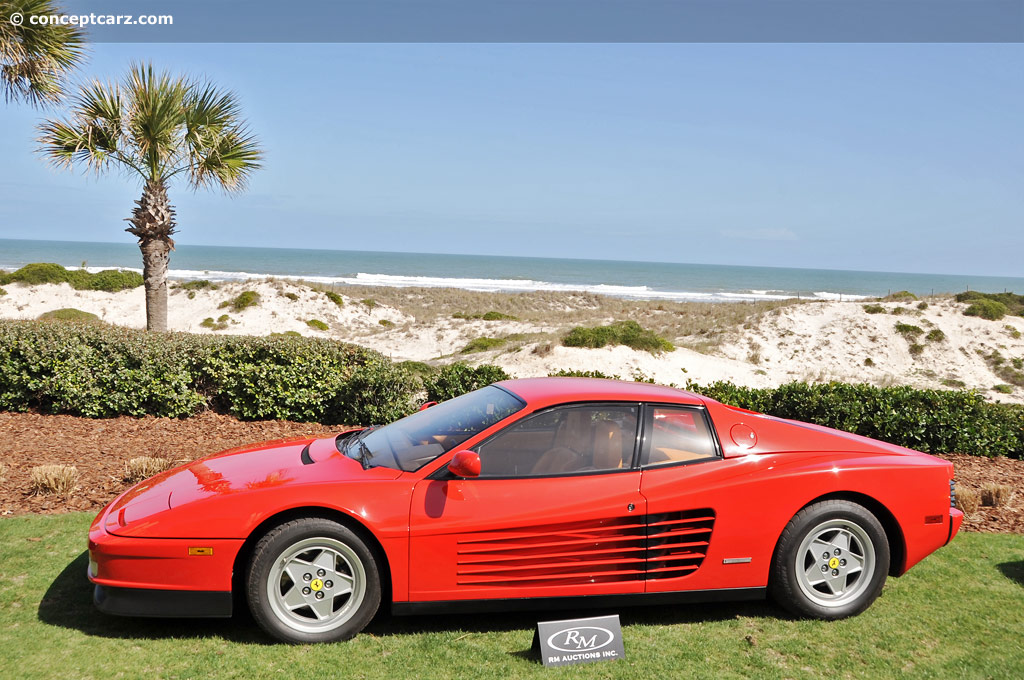
Coupe
Chassis #: ZFFSG17A1M0086824
View info and history
Auction entries : 2
The Ferrari Testarossa was produced from 1984 through 1991 with 7,177 examples built. It evolved into the 512TR of 1991 and the F512M of 1995. With each evolution, the styling, interior, and drivetrain were enhanced, retaining its ability to exceed speeds of 180 mph, accelerate to 60 mph in approximately 5 seconds, and attain nearly 0.9G lateral acceleration. A total of 2,261 examples of the 512 TR (1991 to 1994) were built followed by 501 of the F512 M (1994 through 1996). All three rested on a 100.4-inch wheelbase, had an overall length of 176.6 inches, and employed the 4.9-liter longitudinally mid-mounted flat-12 engine. The final iteration of the Testarossa, the F512 M, produced 434 horsepower at 6,750 RPM and 370 ft-lb of torque at 5,500 RPM.
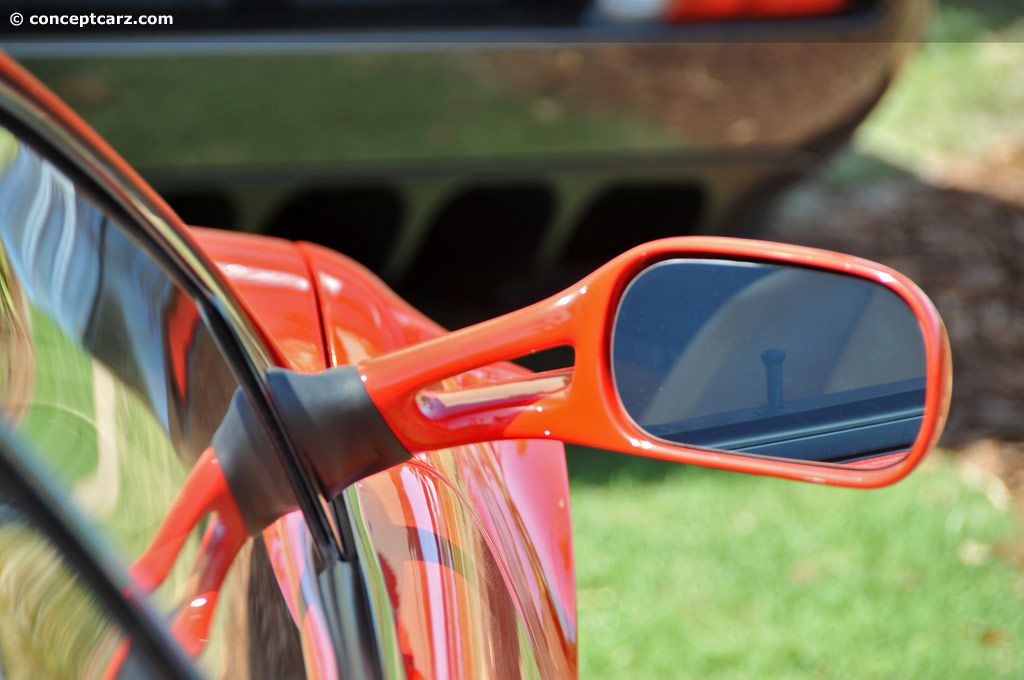
Coupe
Chassis #: ZFFSG17A1M0086824
View info and history
Auction entries : 2
by Daniel Vaughan | Jun 2022
Related Reading : Ferrari Testarossa History
The Ferrari Testarossa leaped to center stage of the automotive world in 1984 and remained there for 11 years as the worlds fastest regular production car. It was the definition of supercar in its era, the innovative benchmark against which all contemporary sports cars were measured. When Ferrari set about creating a replacement for the Berlinetta Boxer, a V12 engine, high performance, style....
Continue Reading >>
Continue Reading >>
Related Reading : Ferrari Testarossa History
Receiving an incredibly warm welcome when it arrived on the scene, the impossible to ignore Ferrari Testarossa made the cover of Road %26 Track magazine not once, but NINE times in only five years. Priced at a steep %24181,000 in 1989, plus a %242,700 gas-guzzler tax, the Testarossa was a 12-cylinder mid-engine sports car manufactured by Ferrari. Succeeding the Berlinetta Boxer, the exotic two-door....
Continue Reading >>
Continue Reading >>
Similar Automakers
Similarly Sized Vehicles
from 1991
1991 Ferrari Testarossa Vehicle Profiles
Recent Vehicle Additions
Performance and Specification Comparison
Price Comparison
$122,180
$161,600
$399,155
Testarossa Specification Comparison by Year
Year
Production
Wheelbase
Engine
Prices
Related Automotive News

30th Anniversary Of The F40
Maranello, 21 July 2017 - Thirty years have passed since the official presentation of the F40, which took place on 21 July 1987 at the Civic Centre in Maranello, now home to the Ferrari Museum. Created to celebrate the companys 40th anniversary,...

MY18 Granturismo And Grancabrio Star At Goodwood Festival Of Speed
World debut for the restyled Maserati GranCabrio and European premiere for the GranTurismo at Goodwood Festival of Speed, on 29 June – 2 July 2017.
Maserati tells the story of 70 years of GranTurismo by displaying a collection of iconic GT...

Granturismo Model Year 2018 Makes Its World Debut In New York
Maserati reveals the restyled GranTurismo at New York Stock Exchange today.
Maserati CEO Reid Bigland will ring the closing bell of the NYSE at 4pm EST.
Modena, 27 June 2017 – Maserati has chosen the New York Stock Exchange as the...

LAMBORGHINI MIURA 50th ANNIVERSARY AT 2016 AMELIA ISLAND CONCOURS d'ELEGANCE
The 21st annual Amelia Island Concours dElegance will celebrate the 50th anniversary of the legendary Lamborghini Miura the car that changed the exotic car universe forever.
The landmark Miura was introduced as a rolling chassis at the 1965 Turin...

REVERED FERRARI 250 LM LEADS SUPERLATIVE ROSTER OF ITALIAN SPORTS CARS AT RM'S FLAGSHIP MONTEREY SALE
· RM Auctions announces a legendary 1964 Ferrari 250 LM by Scaglietti as the latest multi-million-dollar highlight for its flagship Monterey sale, August 15–16 in California
· 250 LM leads a superb roster of no less than 26 Ferraris at...




























